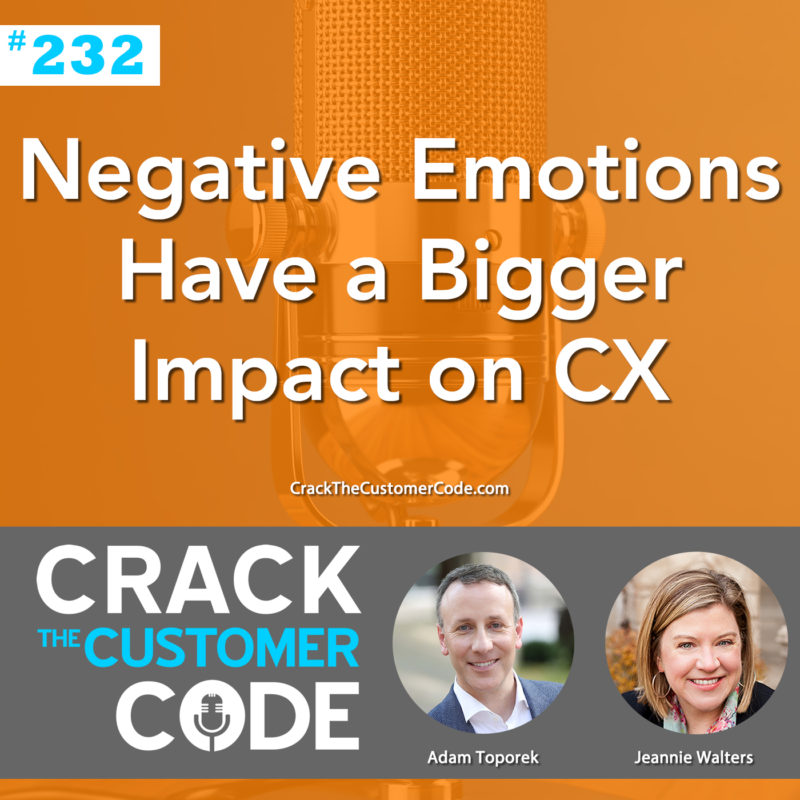What is the backbone of CX success?
They say in every relationship, it’s important to have more positive interactions than negative ones. In the healthiest of relationships, the ratio of positive to negative is 2:1 or greater.

The same holds true for the relationship you have with your customer. In fact, your customer needs even MORE from you. The best customer experience brands, those Forrester labels as “Elite Brands” in their 2018 U.S. CX Index, achieve CX success by providing an average of 22 emotionally positive experiences for each negative experience.
That’s 22:1 – eleven times what your significant other expects!
The recommendations for brands looking to achieve this elite status is to focus on emotion for greater CX success.
To which I say, didn’t we already know this? Not to be a know-it-all, but I’m pretty sure I did and you did, too.

We don’t believe what we know to be true unless we have a report or index or dashboard that tells us so.
The best brands focus on emotion because…wait for it…they actually CARE about their customers. They proactively consider each experience their customer has with their brand and they do their very best to make it a good one. They reduce effort for customers everywhere and they show a little – or a lot – of their authentic brand personality.
Emotion is not new, for goodness sake. And humans have never NOT had emotions. We’ve been these nuanced, irrational and emotional creatures since DAY ONE.

Maybe it was who to marry. Or taking a big job. Or buying a car.
I doubt you can think of those big decisions without considering the emotions that you felt. You were weighing options based on logic, yes, but also based on how you felt. Sometimes we can identify those emotions immediately, like worry or joy, but sometimes it’s trickier. We just feel a certain way and can’t always articulate why.
Why are we forcing ourselves to define our customers’ decisions based on pure logic and analysis? Even your most pragmatic customer is still human. Yes, this applies in business-to-business situations, too.
No matter what those reports list, those numbers still represent customers. They still represent humans. And those humans will always have emotions which play into every decision.

Adam Toporek and and Jeannie Walters explore neuroscience and new study data to better understand the emotional impact on customer experience. Listen in!
Can we stop acting like emotions don’t belong in business, and like the data will save us?
The data is only as good as the questions we ask. But some questions don’t need to be asked at all.
If you find yourself thinking, “this is a terrible way to treat people,” or “why don’t we make this easier?” or “no wonder everyone hates this company…” Then, maybe, possibly, you should rely on the emotions you’re feeling. Are you feeling shame or a loss of control? Are you feeling overwhelmed with the way customers are being treated?
That’s enough. It’s enough to get started. It’s enough to do your best to make a difference for customers. And it’s enough to trust your emotions and honor and respect those of your customers.
I hope not. Data has a big place in understanding customers, but we need to stop acting like emotions are a new idea. They matter, both for you and your customers.
 Jeannie is an award-winning customer experience expert, international keynote speaker, and sought-after business coach who is trailblazing the movement from “Reactive Customer Service” to “Proactive Customer and Employee Experience.” More than 500,000 people have learned from her CX courses on LinkedIn Learning, and her insights have been featured in Forbes, The Chicago Tribune, The Wall Street Journal and NPR.
Get Jeannie’s insights in your inbox each week by subscribing to The Weekly Win and follow her on LinkedIn, Instagram and YouTube.
Jeannie is an award-winning customer experience expert, international keynote speaker, and sought-after business coach who is trailblazing the movement from “Reactive Customer Service” to “Proactive Customer and Employee Experience.” More than 500,000 people have learned from her CX courses on LinkedIn Learning, and her insights have been featured in Forbes, The Chicago Tribune, The Wall Street Journal and NPR.
Get Jeannie’s insights in your inbox each week by subscribing to The Weekly Win and follow her on LinkedIn, Instagram and YouTube.